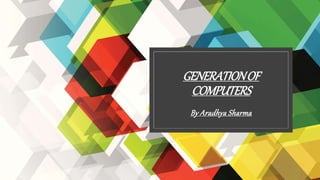
Generation of computers
- 2. GENERATION ◦ Generationincomputerterminologyisachangeintechnologya computeriswasbeingused.Initially,thegenerationtermwas usedtodistinguishbetweenvaryinghardwaretechnologies.Nowadays,generationincludesbothhardwareandsoftware,which togethermakeupanentirecomputersystem. ◦ Therearefivecomputergenerationsknowntilldate.Eachgenerationhasbeendiscussedindetailalongwiththeirtimeperiod andcharacteristics.Inthefollowingtable,approximatedatesagainsteachgenerationhasbeenmentioned,whicharenormally accepted.
- 3. First Generation Generation HardwareCharacteristics Software Characteristics OtherFeatures First (1940-1956) Vacuum Tubes Machine Language Bulky In Size Magnetic Drums For Memory Solved One Problem At A Time Highly Unreliable Input on punch card and paper tapes Mostly Scientific Applications Difficult Commercial Production Output in form of printouts Limited commercial use and costly Difficult to use
- 4. FIRSTGENERATION ◦ The period of first generation was from 1940-1956. The computers of first generation used vacuum tubes as the basic components for memory and circuitry for CPU (Central Processing Unit). These tubes, like electric bulbs, produced a lot of heat and the installations used to fuse frequently. Therefore, they were very expensive and only large organizations were able to afford it. ◦ In this generation, mainly batch processing operating system was used. Punch cards, paper tape, and magnetic tape was used as input and output devices. The computers in this generation used machine code as the programming language.
- 5. SecondGeneration Generation HardwareCharacteristics SoftwareCharacteristics OthersFeatures Second(1956-1963) Transiters Batch processing system Faster ,smaller , more reliable Magnetic Cores Memory High level programming languages developed Easier to program than previous generation systems Magnetic tapes Assembly language Production was still costly Disks for secondary storage Scientific and commercial applications
- 6. SecondGeneration ◦ The period of second generation was from 1956-1963. In this generation, transistors were used that were cheaper, consumed less power, more compact in size, more reliable and faster than the first generation machines made of vacuum tubes. In this generation, magnetic cores were used as the primary memory and magnetic tape and magnetic disks as secondary storage devices. ◦ In this generation, assembly language and high-level programming languages like FORTRAN, COBOL were used. The computers used batch processing and multiprogramming operating system.
- 7. ThirdGeneration Generation HardwareCharacteristics SoftwareCharacteristics OtherFeatures Third Generation (1964-1971) IC with SSI and MSI technologies Timesharing operating Systems Faster ,smaller ,easier and more cheaper Larger magnetic Cores Memory Machine independent software Scientific commercial online apps Larger Capacity Disks and magnetics secondary storage Standardization of high level programming languages Commercially easier to use and upgrade than previous systems Minicomputers
- 8. ThirdGeneration ◦ The period of third generation was from 1964-1971. The computers of third generation used Integrated Circuits (ICs) in place of transistors. A single IC has many transistors, resistors, and capacitors along with the associated circuitry. ◦ The IC was invented by Jack Kilby. This development made computers smaller in size, reliable, and efficient. In this generation remote processing, time-sharing, multiprogramming operating system were used. High-level languages (FORTRAN-II TO IV, COBOL, PASCAL PL/1, BASIC, ALGOL-68 etc.) were used during this generation
- 9. Forth GENEARTION Generation Hardwarecharacteristic SoftwareCharacteristic OthersFeatures Fourth (1972- 2010) Microprocessors , semi-conductor GUI Based Operating system Small affordable reliable and easy to use PC Personal Computers Multiprocessing OS General purpose machine Super computers based on multiprocessing technology Network based and super computing application Easier to upgrade and produce commercially Spread of high speed computer networks Multimedia, Internet, applications Powerful, cheaper and easier to use PC machines Optical disk as portable read only storage media Object Oriented Design and programming Rapid software Development Possible Larger capacity main memory hard disks Parallel programing Portable Computers Notebooks ,powerful PC and workstations Disturbed OS Internet World Wide Web
- 10. FourthGeneration The period of fourth generation was from 1972-2010. Computers of fourth generation used Very Large Scale Integrated (VLSI) circuits. VLSI circuits having about 5000 transistors and other circuit elements with their associated circuits on a single chip made it possible to have microcomputers of fourth generation. Fourth generation computers became more powerful, compact, reliable, and affordable. As a result, it gave rise to Personal Computer (PC) revolution. In this generation, time sharing, real time networks, distributed operating system were used. All the high-level languages like C, C++, DBASE etc., were used in this generation.
- 11. FIFTH Generation Generation HardwareCharacteristics SoftwareCharacteristics OthersFeatures Fifth (present and beyond) Superconductors Can Understand Human Language Voice Recognition Powerful servers ,supercomputers Capable of learning and self organization Interspace Cluster computing
- 12. FIFTHGENERATION ◦ The period of fifth generation is 2011-till date. In the fifth generation, VLSI technology became ULSI (Ultra Large Scale Integration) technology, resulting in the production of microprocessor chips having ten million electronic components. ◦ This generation is based on parallel processing hardware and AI (Artificial Intelligence) software. AI is an emerging branch in computer science, which interprets the means and method of making computers think like human beings. All the high-level languages like C and C++, Java, . Net etc., are used in this generation.